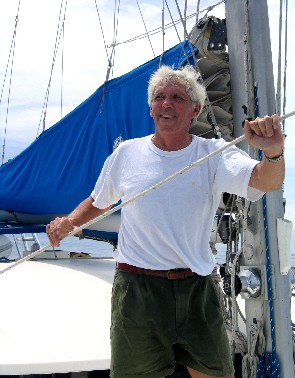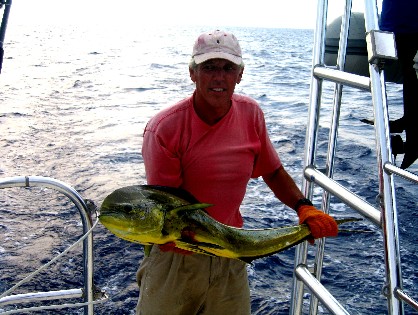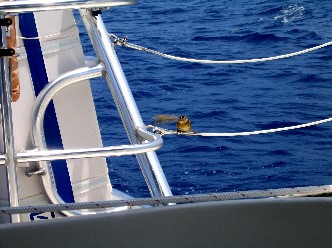26 May 2005
Enroute to Panama From Riviera Beach, FL to the East End of Cuba
The Old Bahama Channel
One book cruisers cannot do without is Jimmy Cornell's World Cruising Routes. Jimmy is a world class sailor and entrepreneur extraordinaire. Having made several circumnavigations, he draws upon his experience and the experience of others and synthesizes it all into an informative text describing what routes to take from point to point during certain times of the year. Even if you don't cruise offshore, it one of the must have books for fantasizing about a trip you might want to take. On our current passage from Florida to Panama, Jimmy recommends the Old Bahama Channel then the Windward Passage which takes us around the eastern tip of Cuba before heading directly to the southwest Caribbean. Why it's the "Old" Bahama Channel or where one would find the "New" Bahama Channel escapes me.
The Old Bahama Channel is one of the busiest shipping channels we have encountered. Since the channel is about 10 miles wide, the traffic is funneled making for a greater number of boat sightings. At night the lights tell the story of the type of vessel and the direction you are approaching it or more likely the direction it is approaching you. But it is often an anxious guessing game.
 When there are three vessels on the horizon, you spend a great deal of time looking through the binoculars trying to determine which way and at what speed everyone is going. Boats of significant size have the correct navigation lights but more than likely they also have an abundance of superfluous lights that confuse what is a simple identification system. When there are three vessels on the horizon, you spend a great deal of time looking through the binoculars trying to determine which way and at what speed everyone is going. Boats of significant size have the correct navigation lights but more than likely they also have an abundance of superfluous lights that confuse what is a simple identification system.
A tug with a plethora of yellow lights disguises itself since the proper light for a vessel towing is a yellow light over a white at the stern. It is impossible to identify the boat correctly until it was close and then we start looking for the barge and yep there it is 200 meters behind with only the smallest of navigation lights. A red navigation light on a small freighter is hidden in an array of green lights from the green tinted windows. Many vessels are lit up like Times Square obliterating the navigation lights in a collage of colors. All this puts an edge on the night watch.
Fishing vessels obscure their lights since they have high wattage lights on the stern deck to help with the work to be done. Typically they move very slowly and are therefore within sight for a longtime. And then there are boats with lights that are inoperative or boats that still have Christmas decorations hanging from the rigging. In retrospect you travel down an expressway in your car at 70 miles per hour coming within a few feet of 18 wheelers traveling in the opposite direction without thinking about it. So how bad can it be out here? Well there are no yellow lines and you are never certain that the other guy is looking. We are very small in relationship to even the smallest island freighter and even though sailboats typically have the right of way, the right of way is established by the right of tonnage.
It is the change of seasons in the Caribbean meaning it is either just before or just after hurricane season and the best time to do longer passages since the weather is more benign during this transition period. We are closing in on Cuba and if we stay on our rumb line we will pass within less than two miles of this forbidden island. Trade and travel restriction were imposed on Cuba in 1959-60 and later under the Carter administration travel restriction to Cuba was relaxed. Castro approached the Clinton administration about improving relations and expanding travel but in the end Clinton signed the Helms-Burton Law (now there are a couple of Congressmen that could bring a tear to your eye) that restricted travel and trade with Cuba by any individual or nation and sanctioned US citizens who traveled to Cuba. It is not illegal to travel to Cuba and it is not illegal to send money to your relatives in Cuba but it is illegal to spend any money in Cuba. Spending money is viewed as trading with the enemy. During the Clinton years the law was loosely interpreted and many cruisers traveled to Cuba using a Canadian host organization or other means but under the Bush administration the law is strictly enforced. Open immigration from Cuba to the US was ended in 1994 a policy favored by most Cuban Americans. Over the last forty years, Cuban Americans have rejuvenated southern Florida and the Republican Party, while awaiting Castro's demise.
Along the northern shore of Cuba the Cuban Cost Guard monitors boat traffic. A station from Cayo Peredon Grande radios every vessel within site, at least during the day, and ask a series of questions in heavily accented English. You had better be ready to spell everything phonetically, such as last port, next port, vessel name, hailing port and you need to be patient, the bureaucracy in Cuba is thorough and slow. At the end of this rather lengthy radio conversation the voice on the other end says "bye-bye and have a nice day."
At this writing the weather is so benign that we find ourselves motoring more than we had planned . We had hoped to save as much fuel as possible for any emergency but here we are, three days into a two week journey and we are making way by running one engine at a time. Our weather forecaster, Chris Parker tells us that there will be plenty of wind after we make the eastern point of Cuba but if need be, there are several places to take refuge or refuel.

One thing we do to while away the hours during a long passage is to fish. Fishing on a sailboat gives you plenty of excuses for not catching fish since you are either going too fast or too slow. Take for example during the days when there is not enough wind to sail and we are motoring against the Gulf Stream. The only fish I saw was the one who took one of my new lures while I was cranking in the bait for the evening. Only then was the bait going fast enough to attract a game fish. It hit within a few feet of the boat and broke the 50 lb. test line. Needless to say it was huge. And then there was the other day when I caught a nice size dolphin at dusk when a herd (I always thought it was a pod but not according to our book of fish and whales) of pilot whales surprised us just after we took this picture. There were too many to count and one of these 18 foot babies breached within twelve feet of the boat. The next thing I saw was the "catch of the day" sliding off the transom. Well, we were excited. Sorry, no pictures of the pilot whales.

On most of our extended passages we end up with a migratory bird onboard, usually something small like a finch or swallow. We are torn on whether to allow the bird to stay onboard and end up a hundred miles from its migratory path or to chase it off . They always appear so exhausted that we allow them to hitch a ride and hope for the best. It also seems that once we allow one onboard a second always shows up. We don't know the fate of this small fellow. Perhaps my friend Gary Reed can identify it for us?
We made our last tack to take us around Cuba late in the afternoon and passed within two mile of the coast. We hear fractured English on the radio calling, "little boat, little boat" and assume the call is for us. We responded but are unable to make contact.
We now have about seven days left in the passage.
Back Next
|